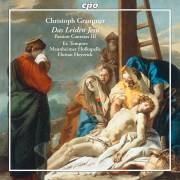Texte paru dans: / Appeared in:
|
|
|
Reviewer: Bertil
van Boer
The series of Passion cantatas
by Christoph Graupner continues with this offering from CPO featuring the
Mannheimer Hofkapelle and the vocal ensemble Ex Tempore, a well-trained
early music group from which the solo sections of these works are drawn.
These three works are from a series composed in 1741, and as one might
expect they reflect a more modern compositional style that is more
introverted and emotional. In the first work, Kommt, Seelen, the
first chorus is halting at first, with the devotion (Andacht) of the
title clear in the choral statements that are divided by conspicuous rests.
Oboes appear selectively, and there are expostulations, even short
exhortations in the chorus that are urgent. The same style is evident in the
brief accompagnato that precedes the aria “Soll mein Heiland.” Here the oboe
solos ask the question of whether Christ should die, while the answer is
plaintively heard in the violins and soprano, clear and precisely performed
by Doerthe Maria Sandmann (or one presumes; the soloists are not specified
further in the notes). The second aria, “Jesus geht zum Kreuz” for baritone,
has the strings closely outlining the hesitant steps, steady but plodding,
with short motivic statements. This cantata, like the other two, closes with
a brief chorale featuring the tune in the chorus while the instruments have
short obbligato moments. One should not expect the cohesiveness of Johann
Sebastian Bach, but rather a more integrated style that does not allow for
the congregation to participate. The second cantata, Sie rüsten sich,
begins with a scurrying introduction with oboes and upper strings softly
treading about each other before the chorus merges into the texture with
soft ease. The first aria is mysterious, perhaps even a bit spooky, in its
soft, mournful tone. This contrasts similarly to the first cantata in the
second aria with a gentle minuet, and in the final chorale each ritornello
of the ensemble and chorus is punctuated by a lone bassoon quietly running
up the scale, even at the final cadence. This is a neat and quite unusual
bit of orchestration. The final cantata, Jesus, auf daß er heiligte das
Volk, includes an ensemble of three oboes, something one finds in Bach
on occasion. The woodwind sound is nicely interwoven with the choral
portions. The first aria is rather plaintive in a minor key reflecting the
“saurer Gang” of the text, while the final aria is more upbeat. All of these
are inflected with good writing for the oboes. There are a couple of things that one should remember about the Graupner cantatas. First, he and Georg Philipp Telemann were masters of the genre, each composing well over 1,000 of them. Second, Graupner was still active as a church composer in 1741, perhaps a decade after Bach had concluded the bulk of his cantata compositions for Leipzig. Third, Graupner was able to adapt his style to the emerging Empfindsamkeit without compromising either convention or the needs of the Lutheran service. Finally, he had at his disposal a fine set of instrumentalists and for them he wrote in a manner that was both solid and yet offered good, well-thought-out textures.
As with the
other two discs of Passion cantatas, the interpretations are sensitive and
precise. The tempos are flowing, not rushed, and the intonation of both
chorus and instruments excellent. While there may be a limited market for
Graupner’s myriad of cantatas, this is one disc well worth having. | |
|
|
|
|
|
|
|
Cliquez l'un ou l'autre
bouton pour découvrir bien d'autres critiques de CD |
|




